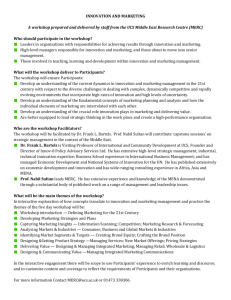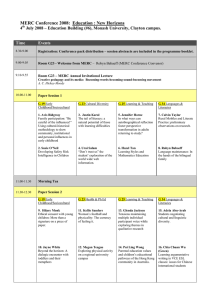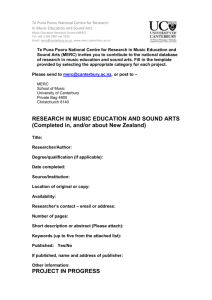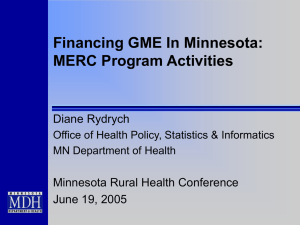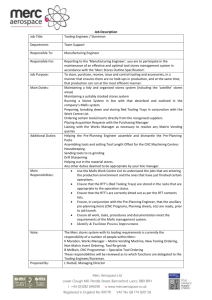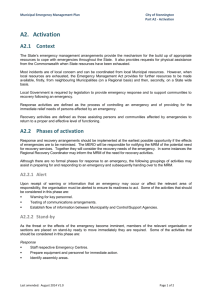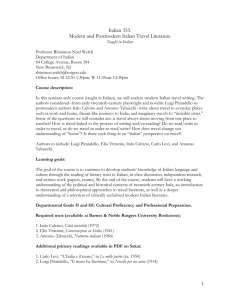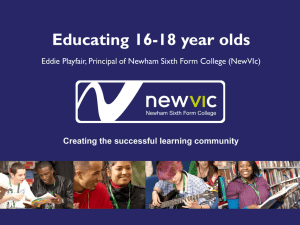handout
advertisement
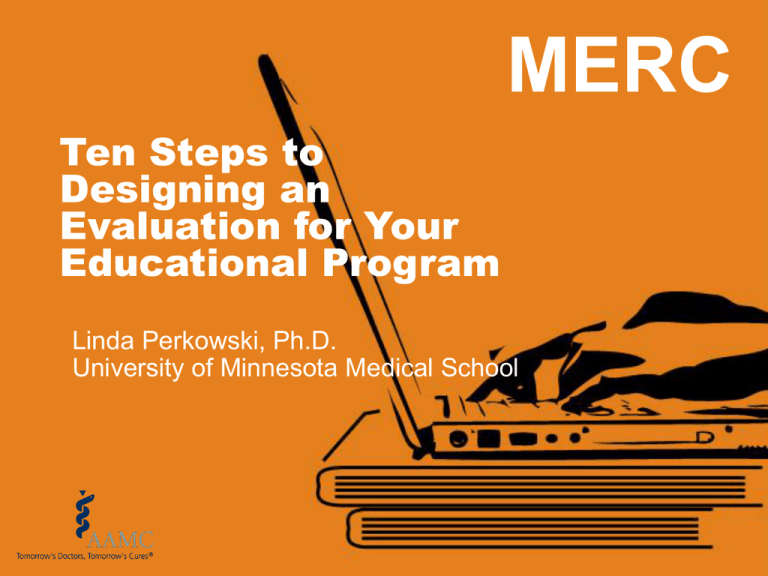
MERC Ten Steps to Designing an Evaluation for Your Educational Program Linda Perkowski, Ph.D. University of Minnesota Medical School Readiness Assurance Test What is Program Evaluation? Systematic collection of information about a broad range of topics for use by specific people for a variety of purposes Patton, 1986 Definitions Evaluation ---- program Assessment ---- individual Formative Evaluation -- to improve Summative Evaluation --- to prove Outcomes Research --- patient care Purposes of Program Evaluation To improve program To determine next steps/make decisions • Help decide to replace, develop further, eliminate, accredit To determine effectiveness To document success To measure outcomes For curricular purposes, evaluation helps Ensure teaching is meeting learner’s needs Identify where teaching can be improved Inform the allocation of resources Provide support to faculty and learners Diagnose and document program strengths and weaknesses Articulate what is valued by the institution Determine that educational objectives met Adapted from Morrison (2003) Influences on the evaluation External • Accrediting agencies • Public • Funding priorities Internal • Who needs what answers? • Who gets to pose the questions? • How will the answers be made known? Barriers to Program Evaluation Tension between implementing and evaluating Lack of skills in conducting applied social science research Paucity of funding, time, and publication outlets Failure to recognize evaluation as scholarship and place in literature Wilkerson, 2000 What is the biggest barrier for you or your institution to collect and analyze program evaluation data? Tension between getting a program implemented and evaluating it Lack of skills Paucity of funding or time Limited outlets to present or publish findings Many Models Goal Oriented/Objective-Based (Tyler) Goals-free Evaluation (Scriven) Judicial/Adversary Evaluation CIPP (Stufflebeam) Kirkpatrick’s 4-level model Situated Evaluation Connoisseurship Evaluation (Eisner) Utilization-Oriented Evaluation (Patton) Logic Model Program Logic Model - MERC Tyler Model - MERC Objectives: Methods 1. Increase their participation in medical education research activities (research presentations and publications) (outcome evaluation) Short survey 2. Apply medical education research principles from MERC to their daily work (outcome evaluation) Short survey Content/Specifics Retrospective pre/post survey •12 closed-ended dichotomous items participation in medical education research activities (ie, collaborating in medical education research project, publishing a peerreviewed publication) Open-ended question Frequency/ Timing Person 6-12 months after completion of MERC MERC Evaluation Committee to launch and analyze data 6-12 months after completion of MERC MERC Evaluation Committee to launch and analyze data Kirkpatrick’s Four Levels of Outcomes 1. Satisfaction 2. Advance in knowledge, skills and attitudes 3. Skills used in everyday environment of the learner 4. Bottom-line a. Effect on participants’ “learners” b. Effect on participants’ career c. Institutional improvements Overview of 10 Program Evaluation Steps (Workplan) Step 1: Identify Users Step 2: Identify Uses Step 3: Identify Resources Step 4: Identify Evaluation Questions/Objectives Step 5: Choose Evaluation Design Step 6: Choose Measurement Methods and Construct Instruments Step 7: Address Ethical Concerns Step 8: Collect Data Step 9: Analyze Data Step 10: Report Results Step 1: Identify Users Who will use the evaluation? • Learners • Faculty • Workshop developers • Administrators • Agencies • Other stakeholders What do they want from the evaluation? Step 2: Identify Uses Generally both formative and summative Individual and program decisions Qualitative and/or quantitative information Consider specific needs of each user • Judgments about individuals • Judgments about project management and processes What uses do you have for program evaluation? Improving existing or new programs Proving that a program works Step 3: Identify Resources What time is needed from everyone? What personnel is needed? What equipment? What facilities? What funds? Step 4: Identify Evaluation Questions/Objectives These go back to the model chosen, but Generally • Relate to specific measurable objectives for Learner Process Outcomes • Wise to include some questions that get at what was not anticipated both as strengths and weaknesses Step 4: Identify Evaluation Questions/Objectives – cont. Evaluation questions should: • Be clear and specific • Congruent with the literature • Focus on outcomes versus process • Outcomes imply change Workshop will improve educator’s skill RATHER THAN How the workshop was given (process) • Align with goals and objectives What are the questions? Process •Ease of use •Efficiency •Relevance •Language Presentation & Organization Evaluation of Learning Development •Needs assmt •Objectives •Materials •Staffing •Design •Interaction •Feedback •Clarity •Quality •Organization Pedagogy •Instructional method •Structure •Active learning •Learner differences •Objectives ~ methods Outcomes •Knowledge •Attitudes •Behaviors Interface ? Evaluation of Cost Implementation •Staff time •Materials •Recruitment •Facilities •Hardware Evaluation of Content Maintenance •Portability •Coordination •Durability •Tech support •Authority •Accuracy •Appropriateness •Breadth •Depth Adapted from Elissavet & Economides (2003) Step 5: Choose Evaluation Designs What ones are appropriate to the questions? Posttest only Satisfaction/reactions X--O Retrospective Pretest Attitudes X--O • Pretest-Posttest Changes in knowledge/attitudes O - -X- - O • Quasi-Experimental Cross-over O - -X- - O- - - - - O O - - - - - O - -X - - O Step 6: Choose Measurement Methods and Construct/Adapt Instruments Common methods • • • • • • • • • Rating forms Self-assessments Essays Exams Questionnaires Interviews/focus groups Direct observations Performance audits Existing data (AAMC questionnaires, Course evals, JAMA) Collect appropriate demographics SOURCES OF DATA What do we have? What do we need? What, realistically, can we do? Group Assignment 1 During this workshop, you will begin to: Evaluate the effectiveness of the CORD program (see handout) Use your experiences and the information in the handout to address the first four steps What would be the best model to use as we begin to develop our plan? Goal oriented/ objective based Kirkpatrick’s 4-level model Logic model Assignment 2 Take your own project/program and begin filling in one of the blank matrices Be prepared to discuss with the group Step 7: Address Ethical Concerns Confidentiality Access to data Consent Resource allocation Seek IRB approval Step 8: Collect Data Timing and response rate Already existing data collection Impact on instrument design (e.g. mail vs. web survey) Assignment of responsibility Step 9: Analyze Data Plan at the same time as the rest of the evaluation Want congruence between question asked and analysis that is feasible Step 10: Report Results Timely Format fits needs of users Display results in succinct and clear manner QUESTIONS??? ©

